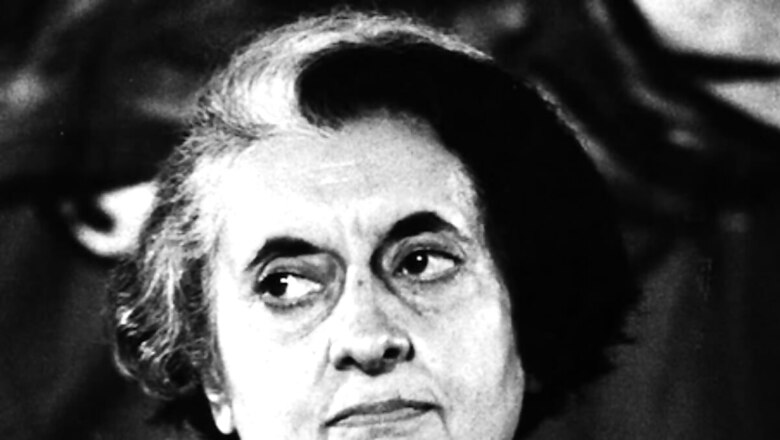
views
With the director relinquishing charge on the very day and his successor looking “completely lost”, AIIMS was in a “grey zone” that fateful October 31, 1984 when a bullet riddled Indira Gandhi was wheeled in, says Dr P Venugopal who went on to operate on the then prime minister.
The veteran cardiologist in his memoir “Heartfelt” gives a detailed account of those four hours in which doctors, surgeons and the nursing staff of Delhi’s All India Institute of Medical Sciences worked tirelessly to save Gandhi.
Venugopal, chief of cardiac surgery at the time, is also the man who performed India’s first heart transplant in August 1994.
“Bullets falling out all over the floor” from her blood soaked sari, the futile attempt to transfuse O-negative blood and political conversations discussing the swearing-in of the next prime minister in the corridors of the hospital … 39 years later, it all comes to vivid recall.
“I was shaken to see the slender figure on the bed; blood spouted from her abdomen and she was drenched completely in her own blood. The delicate face was pale, as though all blood had left the body, and it continued to flow in spurts and pooled around her,” the former AIIMS director writes in his book released last week.
Gandhi was assassinated on the lawns of her residence by two of her security guards. The assailants had fired 33 bullets at her, of which 30 hit her; 23 passed through her while seven were lodged inside.
“I saw that they (doctors) were trying to transfuse the rare O-negative type, which seemed a futile exercise to me as what was going in was coming out from the ruptured body,” says the 81-year-old, describing the scenes as “chaotic to say the least”.
“A sea of AIIMS personnel milled around. I moved towards Dr HD Tandon, who was relinquishing his charge as director that very day, and Dr Sneh Bhargava, who was taking over. They looked completely lost; clearly, the grey zone of who was director that day paralysing any decision or action. They both turned to me, mutely seeking guidance,” he adds As chief of cardiac surgery, Venugopal says he was looked up to for advice by most and had to take an immediate decision.
“… I ordered her to be taken to the OT so we could stem the profuse flow of blood … The urgency was so important I did not even wait for the signed consent form and simply took the lead.” His final plan of action: “To stem the bleeding by putting her on the bypass machine and clamping the descending aorta so that no blood flowed to the abdomen, which was riddled with bullets.” They worked on the patient for four hours and Venugopal remembers changing his OT scrubs thrice as they kept getting blood-soaked. Around 2 pm, they tried to take her off the bypass but were not able to revive her.
“A feeling of sick despair settled deep in my stomach, as I stepped out to inform her people … Rajiv Gandhi, who was touring the eastern part of the country, was on his way back, and the consensus was to wait for his arrival,” he recalls .
Venugopal, credited with over 50,000 heart surgeries, maintains to this day that if the former PM had been “covered or dragged to cover, she would have survived the first couple of bullets”.
“What appeared was that she had fallen at the first bullet, and the people accompanying her had run back, leaving her alone on the ground. This provoked the assassin to step right up and empty multiple rounds from his machine gun into her at point-blank range,” he says.
With his ringside view of one of the most important political developments of the time, Venugopal was the “mute” and “unwitting” spectator to the parleys for power that began to happen soon after the death of Indira Gandhi.
From the snatches of conversations he caught while present in the nurses’ room — which became the hub of “discussion, debate and heated parleys” for the next few hours — the “main concern was if the President (Giani Zail Singh) would be ready to swear Rajiv Gandhi in as Prime Minister”.
So, the debate, with close Gandhi aide Arun Nehru pitching in, was whether the vice-president (R Venkataraman), who was officiating for the president travelling overseas, could be borne upon to do the honours.
“Another section felt that would be inappropriate. Things went back and forth this way. The general feeling was that the President may call upon the senior-most cabinet member and throw a spanner in the works!” he says.
Rajiv Gandhi was sworn-in as the seventh prime minister of India the same day. At 41, he was the youngest prime minister of India.
Following Indira Gandhi’s assassination, violence erupted in Delhi and other parts of the country, leading to mob attacks on Sikhs and their properties. Over 3,000 Sikhs were killed across India, most in Delhi. “Heartfelt: A Cardiac Surgeon’s Pioneering Journey”, published by HarperCollins India and written by the doctor with his wife Priya Sarkar, is a rare account of the surgeon’s personal and professional milestones and the controversies that surrounded him during his four-decade tenure, say the publishers.




















Comments
0 comment